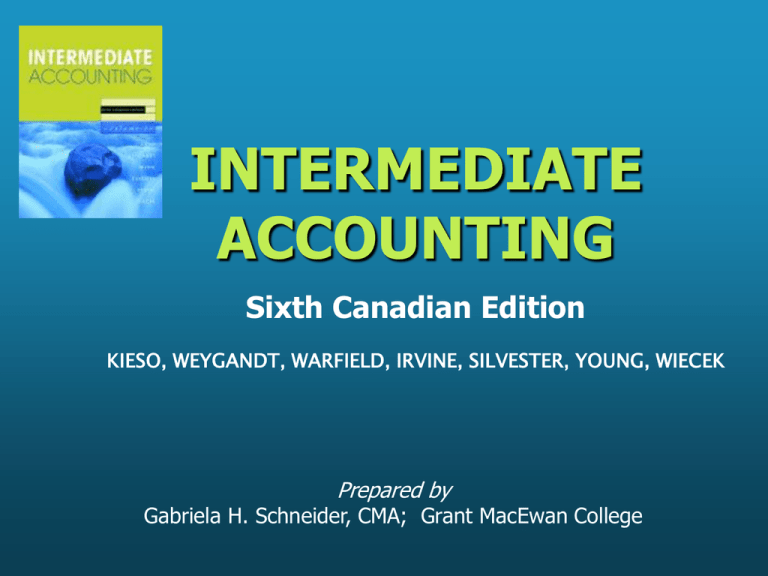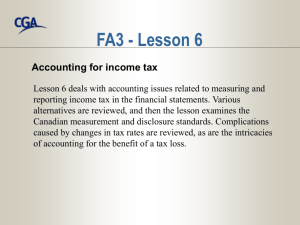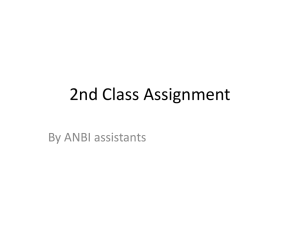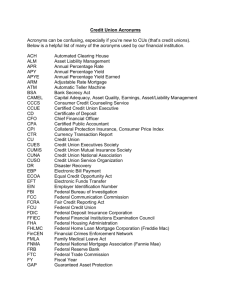
INTERMEDIATE
ACCOUNTING
Sixth Canadian Edition
KIESO, WEYGANDT, WARFIELD, IRVINE, SILVESTER, YOUNG, WIECEK
Prepared by
Gabriela H. Schneider, CMA; Grant MacEwan College
CHAPTER
19
Income Taxes
Learning Objectives
1. Explain the difference between accounting
income and taxable income.
2. Explain what a taxable temporary difference is
and why a future tax liability is recognized.
3. Explain what a deductible temporary difference
is and why a future tax asset is recognized.
4. Differentiate between timing, temporary, and
permanent differences.
Learning Objectives
5. Prepare analyses and related journal entries to
record income tax expense when there are
multiple temporary differences.
6. Explain the effect of various tax rates and tax
rate changes on future income tax accounts.
7. Apply accounting procedures for a tax loss
carryback.
8. Apply accounting procedures and disclosure
requirements for a tax loss carryforward.
Learning Objectives
9. Explain why the future income tax asset account
is reassessed at the balance sheet date.
10. Explain the need for and be able to apply
intraperiod tax allocation.
11. Identify the reporting and disclosure
requirements for corporate income taxes.
12. Describe key aspects of the asset-liability
(liability) method and identify outstanding issues
with this method.
Accounting for Income Taxes
Fundamentals of
Accounting for
Income Taxes
Accounting for
Intraperiod
Financial
Income Tax Loss Tax Allocation Statement
Carryover Benefits
Presentation
Accounting income
and taxable income
Introduction
Objective
Loss carryback
illustrated
Illustration
Future taxable
amounts and future Loss carryforward
taxes
illustrated
Future deductible
Review of future
amounts and future tax asset
taxes
Calculation of
taxable income
Tax rate
considerations
Balance sheet
presentation
Review of
Asset-Liability
Method
Some
conceptual
questions
Income
statement
Comprehensive
presentation
Illustration
Other
disclosures
Permanent vs. Timing
Differences
• Taxable income is determined by taking the
accounting income and adjusting it for
permanent and timing differences
• CICA Handbook, Section 3645 refers to the
accounting for future tax liabilities and future
tax assets based on the tax impact of the
timing differences
Temporary and Permanent
Differences
Temporary Differences
Example: Tax and book
depreciation deductions
may be different
• These are differences in
revenue and expense
amounts reported on tax
returns and for financial
purposes
• Over a given period, they
reverse
Permanent Differences
Example: Interest on
municipal obligations is
not taxed but is income
for accounting purposes
• Items included on the
financials, but either
excluded or not deducted
on tax return
• These differences do not
reverse
Summary of Temporary Differences
When recorded When recorded
Transaction
in books
on tax return
Deferred
tax effect
Revenue
or Gain
Earlier
Later
Liability
Revenue
or Gain
Later
Earlier
Asset
Expense
or Loss
Earlier
Later
Asset
Expense
or Loss
Later
Earlier
Liability
Permanent Differences Examples
• Items, recognized for financial accounting
purposes, but not for income tax purposes:
• Non-tax-deductible expenses (fines, expenses
relating to non-taxable revenue)
• Dividends from taxable Canadian corporations
• Items, recognized for tax purposes, but not
for financial accounting purposes:
• Depletion allowance of natural resources in excess
of cost
Summary of Permanent
Differences
Sources of PERMANENT DIFFERENCES
Some items
are recorded
in Books
but NEVER
on tax return
Other items
are NEVER
recorded in books
but recorded
on tax return
No future tax effects
for permanent differences
Timing Differences
• Relate to income
• Temporary differences relate to balance sheet
values
• Cause the balance of a temporary difference
to change from period to period
• Originating timing difference
• Cause of the initial difference
• Reversing timing difference
• Causes a temporary difference to decrease
Future Tax Asset and
Future Tax Liability - Sources
• Future taxes may be a:
• Future tax liability, or
• Future tax asset
• Future tax liability arises due to net
taxable amounts in the future
• Future tax asset arises due to net
deductible amounts in the future
Recording Future Tax Liability Example
• Book tax expense =
• Tax liability
• Journal Entry:
=
Income Tax Expense
Future Tax Liability
Tax Payable
$20,000
$18,000
20,000
2,000
18,000
Recording Future Tax Asset Example
• Book tax expense =
• Tax payable
=
• Journal Entry:
$5,000
$6,000
Income tax expense 5,000
Future Tax Asset
1,000
Tax payable
6,000
• Future tax asset is recognized for all
deductible differences
Temporary Differences Originating & Reversing
Year
Tax Expense Tax Liability Difference
(per GAAP) (per CCRA)
Nature
FTA / FTL
1
$17,600
$16,000
$1,600
FTL
2
$17,600
$16,800
$ 800
FTL
3
$17,600
$18,400
$ 800
FTA
4
$17,600
$19,200
$1,600
FTA
Net Future Tax Effect
$ -0-
Future Taxes – Final Notes
• Use separate accounts, but remember to report the
net effects
• A future tax asset or liability is classified as long-term
if the item which originated or caused the future tax
amount is long-term
• Future tax amounts have no impact on the current
year’s tax calculations
• On the income statement, report current year’s
income tax separately from future year’s income tax
expense or benefit
• The Future Income Tax Asset account is periodically
reassessed
Tax Loss Carryback and
Carryforward
• The amount reported is the tax calculated
from the loss
• May be carried back three years, or
forward for the next seven years
• When applying the carry back, always
apply to the oldest available year first
• Tax loss carry forward is reported if it is
likely that a profit will be earned in future
periods
Intraperiod Tax Allocation
• Income tax expense is to reported with
its related item
• Intraperiod Tax Allocation
• Tax expense is allocated within the
financial statements of the current period
• Interperiod Tax Allocation
• Tax expense is allocated between years
Basic Principles of
Accounting for Income Tax
• Asset-liability method (liability method)
objectives
• Recognize taxes payable (refundable)
amount for the current year
• Recognize future tax liabilities or assets for
events (transactions) that have been
included in the current year’s financial
statements or tax returns
• Basic principles to achieve these
objectives
Basic Principles of
Accounting for Income Tax
1. Current tax liability or asset is based on current
year’s taxes payable (or refundable) and is
recognized in the current year
2. A future tax liability or asset is recognized for
future tax effects of temporary differences and
carryforwards
3. Measurement of current and future tax liabilities
and assets is based on the tax rate expected at
the time the liability or asset will be settled
4. Future tax asset is reduced by any tax benefits
not expected to be realized
COPYRIGHT
Copyright © 2002 John Wiley & Sons Canada, Ltd.
All rights reserved. Reproduction or translation of
this work beyond that permitted by CANCOPY
(Canadian Reprography Collective) is unlawful.
Request for further information should be
addressed to the Permissions Department, John
Wiley & Sons Canada, Ltd. The purchaser may
make back-up copies for his / her own use only and
not for distribution or resale. The author and the
publisher assume no responsibility for errors,
omissions, or damages, caused by the use of these
programs or from the use of the information
contained herein.






